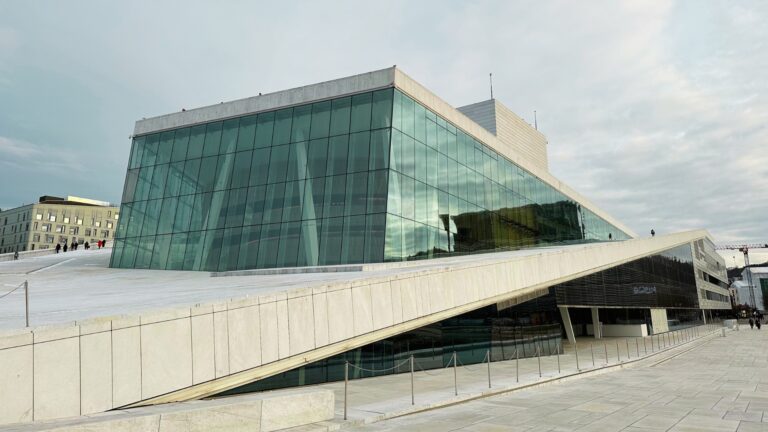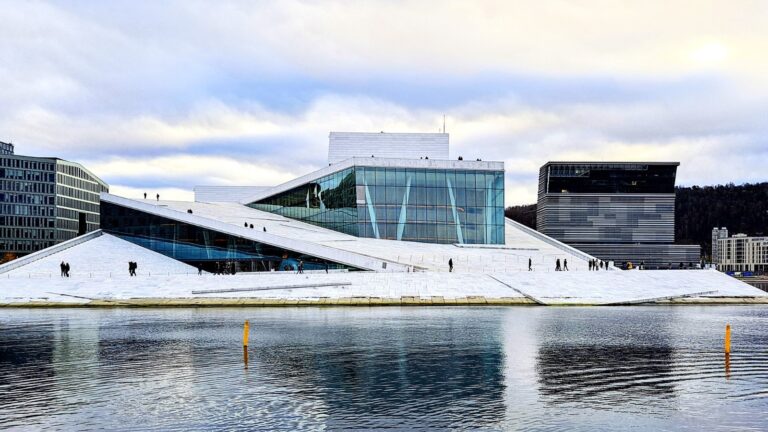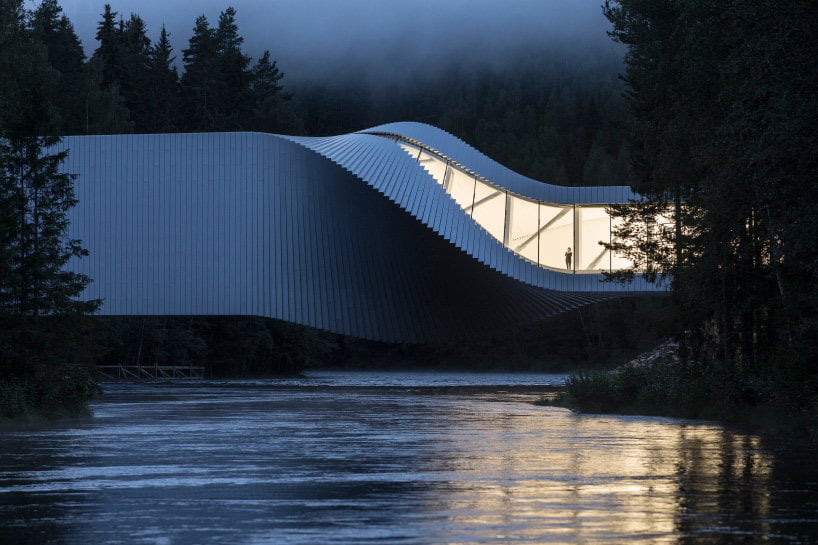Scandinavian interior design is world-famous for its minimalist elegance, but did you know that Norway’s modern architecture is just as renowned?
While Norway is often associated with old-style cabins, stave churches and time-honoured wooden seaside warehouses, the country boasts some of the world’s top examples of modern architecture.

The world of Norwegian architecture really stands out in this field for how it blends buildings with the landscape, and vice versa.
Its buildings seem to fit the landscape, and once inside, they frame the view nicely, making the most of the stunning surroundings.
From Oslo's sleek Opera House to the innovative restaurant Under, submerged beneath the North Sea waves, the country's buildings tell a story of creativity fused with sustainability.
Get ready to see Norway through the lens of its modern masterpieces!
The new Deichman Library
Where: Oslo
Architect firms: Lund Hagem Arkitekter and Atelier Oslo
If I had to choose a top favourite out of all the buildings in this article, it would be Oslo’s stunning new main library.

The building already looks intriguing from the outside, with its iconic cantilevered fifth floor jutting out towards the Oslofjord.
But indoors is where the building really comes to life. When was the last time you entered a public space that’s entirely free and not actively trying to get you to buy something?
The main Deichman Library does this, and does it very well. Each floor has its own specialty, from children’s literature to non-fiction.
You can borrow not only books but board games, musical instruments, sewing machines or 3D printers (the latter to be used on site of course). It also has auditoriums, meeting rooms and co-working spaces where you can just set up your laptop and do a bit of work.
In fact, if you want to meet up with a few friends and finish that uni project, you better show up early because the space is extremely popular. I myself did a half-day of work there once, when I was in Oslo for work and without office space.

The views from the top are fantastic. Go see it. You won’t regret it.
Mjøstårnet: A pioneering wooden skyscraper
Where: Brumunddal, 1.5 hours north of Oslo
Architect firm: Voll Arkitekter
Mjøstårnet is an impressive 18-storey tower in Brumunddal, Norway. It rose to fame as the world's tallest wooden building upon its completion in 2019, before being surpassed by some building for rich people in Wisconsin.
It’s named after Lake Mjøsa, Norway's largest lake, just about 100 kilometres north of Oslo. The building houses a hotel, apartments, offices, and a restaurant.
The design strategically employs timber for both vertical and lateral structural elements, including floor spanning systems, which classifies Mjøstårnet as an all-timber structure.
To meet comfort criteria and improve acoustics, concrete slabs were incorporated into the top seven floors.
Why use wood for skyscrapers instead of steel and concrete, you ask? Aside from being more sustainable (steel and cement production generates a lot of CO2), it’s more lightweight and allows for a quicker construction process.
The Vennesla
Where: Vennesla, 20 min. North of Kristiansand
Architect firm: Helen & Hard
The Vennesla Library and Cultural Center has received several awards both nationally and internationally for its outstanding architecture. When stepping inside, it’s easy to understand why.

The building uses laminated timber for structure, most visibly for its roof, supported by 27 striking ribs that evoke the skeleton of a whale.
This design choice creates a unique “cathedral of knowledge” visual experience that is definitely Instagram-worthy.
The “ribs” morph into shelving at the ends, storing the library’s books, but as libraries go, it definitely looks eerily uncluttered.
The building also includes a cinema hall with a stage and 300 seats, and constitutes a central public meeting place for the little town of Vennesla.
Manshausen island cabins
Where: Nordskot, 3.5 hours north of Bodø
Architect firm: Stinessen Arkitektur
If you’re an off-the-beaten-track kind of person, the Manshausen Island cabins are sure to pique your interest.
Located on a small island off the coast of the tiny village of Nordskot, north of Bodø, these cabins have won many architectural awards for their minimalism, efficiency and quality.
Again, what sets this modern architecture apart is that it adds value to the landscape instead of taking away from it. The layout of the various cabins differs, but they all have in common huge windows framing the stunning local vistas.

This windowed end of the building often juts out over a rocky outcrop, ensuring an entirely unobstructed view of the surroundings.
The two newest additions bring the concept to the extreme: here, the cabins have two floors, and the entirety of the ceiling and of the seaside-facing wall are made of glass.
In addition to the nine cabins, the complex includes a fine dining restaurant, a conference room and a sauna, making it a prime destination for big budget creative companies.
Oslo Opera House
Where: Oslo waterfront
Architect firm: Snøhetta
Oslo Opera House might not be as instantly recognisable as its Sydney, Australia counterpart, but it wins the prize for usebility.
It’s not unfair to compare the two buildings, since the price tag of the Oslo Opera House was even higher than that of Sydney’s, even after adjusting the latter amount for inflation.

The architect firm behind the Oslo landmark, Snøhetta, truly delivered on its vision of creating a new public space for the city.
The slanted roof, covered in white marble from Carrara, Italy, is open to exploration at no cost. It offers wonderful views of the Oslofjord and the Bjørvika neighbourhood.
This new public space integrates almost magically with the surroundings, slanting all the way to the waters of the fjord. Inside, you are greeted by a light and open foyer featuring a large, undulating oakwood wall.
Behind this wall are the three performance halls, with the main stage at the heart of the building.
The design of the main stage, influenced by rigorous acoustic requirements, features dark, golden woodwork that transforms the space into a grand, resonant wooden instrument.
Outside, at the street level, you can peer through large glass windows to catch glimpses of the activity in the scene painting room, the sewing room, and the hat and mask atelier, offering a rare insight into the behind-the-scenes workings of the opera house.
The building is definitely worth the detour, regardless of whether you want to attend a show or not.
The Twist: Kistefos museum
Where: Jevnaker, 1.25 hours north of Oslo
Architect firm: Bjarke Ingels Group
The Twist blurs the line between museum and artwork. Part of the Kistefos sculpture park, the building itself presents as a larger-than-life sculpture twisting its way across the Randselva river.

The idea for the design came from the park’s simultaneous need for a new bridge and a new exhibition hall for high-calibre international art. The result is a striking white building, suspended over the river and twisting in the middle.
Inside, the building houses three distinct galleries: the Closed Gallery, Twist Gallery, and Panorama Gallery. The Closed Gallery features high ceilings and no windows, creating a controlled environment free from natural light, ideal for certain art displays.
The Twist Gallery, as its name suggests, is where the building’s twist is located, with walls seamlessly transforming into the ceiling as the building rotates 90 degrees.
Finally, the Panorama Gallery at the north end is filled with natural light from its large windows, offering breathtaking views of the surrounding landscape, river, and sculpture park.
Powerhouse Brattørkaia
Where: Trondheim waterfront
Architect firm: Snøhetta
This striking building is impossible to miss if you arrive in Trondheim by sea.
Whether you get to town via Hurtigruten, Havila or one of the multiple cruise lines visiting the port, the natural way to walk to town is via a pedestrian bridge that skirts Powerhouse Brattørkaia.
It’s not so much the visual appearance of this office building that makes it worth mentioning, but its design philosophy as a zero-emissions building.

A clue to that design can be observed from the middle of the pedestrian bridge, where you can clearly see how solar panels cover the entirety of the roof.
With every design decision, Snøhetta has sought to minimise the building’s energy needs. Heating and ventilation require so little that the building is essentially a small power plant for the local area – including an electric bus charging station.
Over the course of its lifetime, including construction, operation and decommissioning, it will have generated more energy than it has consumed.
An information screen visible when approaching the building from the bridge shows how much power is being produced by the solar panels at any given time.
Tverrfjellhytta: The Norwegian wild reindeer pavilion
Where: Hjerkinn, 2.5 hours south of Trondheim
Architect firm: Snøhetta
A must if you drive on the E6 between Oslo and Trondheim, Tverrfjellhytta is one of those prime examples of landscape-enhancing architecture.

Overlooking the Snøhetta mountain, the small building serves as a gateway for visitors to explore the Wild Reindeer Foundation's educational programmes.
It is accessible via a 1.5 km (about one mile) hiking trail and offers a serene vantage point to appreciate the Dovrefjell mountains. The pavilion’s design offers a striking contrast between a rigid, rectangular outer shell and a soft, organic inner core.
This core, crafted from wood and shaped by inspiration from natural erosion processes like wind and water, is nestled within a frame of raw steel and glass.
The result is a blend of natural elements and modern architectural principles, creating a space that feels both timeless and contemporary.
Under restaurant: Dining under the sea
Where: Lindesnes, 1 hour west of Kristiansand
Architect firm: Snøhetta
The name of Under restaurant has a double meaning: in Norwegian, “under” means both “under” and “marvel”. And this restaurant, with its underwater dining room, truly is a marvel.

From the outside, it looks like the building just slid halfway into the ocean. Inside, the vaulted concrete ceiling gives way to a large window at one end, allowing diners to observe the underwater wildlife.
The food alone is worth the detour: head chef Nicolai Ellitsgaard secured a Michelin star after just one year of operations.
However, opening a fine dining establishment in the middle of nowhere a year before the onset of a worldwide pandemic has proven quite difficult.
In the fall of 2023, the restaurant had to let go the entirety of its staff and move to a seasonal schedule, being open only from May to September.
Munch Museum: Leaving no-one indifferent
Where: Oslo waterfront
Architecture firm: Estudio Herreros
They say beauty is in the eye of the beholder, and I must admit there is no beauty in my eye when I behold the new Munch Museum in Oslo. This dystopian aluminium-clad skyscraper stands on the Oslo waterfront like the Opera House’s ugly sibling.

Things don’t really get much better when you get inside. The finishings of the main hall are more reminiscent of an airport than of an art museum.
That being said, the building has its redeeming qualities that earn it a place on this list. The exhibition halls are large and do an excellent job at showcasing Munch’s artwork.
Moving from floor to floor using the escalators, you can see the surroundings through the building’s oh-so-ugly perforated aluminium cladding (at least from the inside you look through it, not at it).
The top floor’s observation deck offers the town’s best views of the Bjørvika area and the Opera house. Curious about the architecture? Listen to this interview with the architect to hear the thought processes and decisions behind the building.
Juvet Landscape Hotel
Where: Valldal, about 1.5 hours east of Ålesund
Architect firm: Jensen & Skodvin Architects
A surreal complex of buildings, Juvet Landscape Hotel is featured in the 2014 science fiction thriller “Ex Machina”.
It’s easy to see why it captured the imagination of director Alex Garland. Each room is its own free-standing building, constructed with minimal impact on the landscape.

They consist of minimalist wooden cubes, which are devoid of distractions like pictures, magazines or televisions, allowing the occupant to fully focus on the vibrant green landscape outside.
The river Valldøla cuts a path through the greenery, and can be viewed from the comfort of the armchairs inside.
Dark interiors increase your focus on the landscape. The various cubes are positioned and oriented in such a way that you can’t see into the neighbour’s room. Film and TV appearances have seen interest in the hotel skyrocket.
The Juvet Landscape hotel inspired similar projects worldwide, such as the Vivood Landscape Hotel in Spain and the Sacromonte Landscape Hotel in Uruguay.
What are your favourite modern buildings in Norway? Let us know your thoughts on these choices, or others, in the comments below.



The Twist is my favorite building. I have not responded to your newsletter, but I read every one of them and always find them very interesting. I also write a monthly newsletter entitled Norwegian-American Cousin Connection about Norwegian and Norwegian-American culture and family history topics.